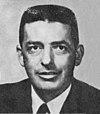Ohio's 19th congressional district was created following the 1830 census and was eliminated after the 2000 census. Between 1863 and 1880, it was represented by future US President James A. Garfield, who became the only sitting House member ever to be elected to the Presidency.
The 20th congressional district of Ohio was created after the 1840 census. It was eliminated in the redistricting following the 1990 census, and redistricted and renumbered as the 10th district.
The 21st congressional district of Ohio was a congressional district in the state of Ohio. It was eliminated in the redistricting following the 1990 census.
The 22nd congressional district of Ohio was eliminated as a result of the redistricting cycle after the 1980 Census.
The 23rd congressional district of Ohio was eliminated as a result of the redistricting cycle after the 1980 Census. The district had been created after the elimination of Ohio's at-large congressional district after the 1950 election.
Ohio's at-large congressional district existed from 1803 to 1813, from 1913 to 1915, from 1933 to 1953 and from 1963 until 1967, when it was banned by the Voting Rights Act of 1965.
Ohio's 2nd congressional district is a district in southern Ohio. It is currently represented by Republican Brad Wenstrup.
Ohio's 1st congressional district is represented by Democrat Greg Landsman. The district includes the city of Cincinnati, all of Warren County and borders the state of Kentucky. This district was once represented by President William Henry Harrison. After redistricting in 2010, the district was widely seen as heavily gerrymandered by state Republicans to protect the incumbent, Steve Chabot. Chabot lost the seat in 2022 to Landsman, after redistricting unified the city of Cincinnati into the district. The city was previously split between the 1st and 2nd districts.
Ohio's 5th congressional district is in northwestern and north central Ohio and borders Indiana. The district is currently represented by Republican Bob Latta.
Ohio's 7th congressional district is represented by Max Miller. It is currently located in the northeastern section of the state, including part of Cuyahoga County.
Ohio's 8th congressional district sits on the west side of Ohio, bordering Indiana. The cities of Hamilton, Fairfield, Middletown, Springfield, Eaton, Greenville, Piqua, and Troy are part of the district. The district was represented by Republican John Boehner, the 53rd Speaker of the United States House of Representatives. On September 25, 2015, Boehner announced his resignation from the speakership and retirement from Congress, which became effective on October 31, 2015.
Ohio's 10th congressional district is represented by Representative Mike Turner (R). The district is based in southwestern Ohio and consists of Montgomery County, Greene County, and a portion of Clark County.
The 14th congressional district of Ohio is in the far northeast corner of the state, bordering Lake Erie and Pennsylvania. It is currently represented in the United States House of Representatives by Republican Dave Joyce.
The 15th congressional district of Ohio is currently represented by Republican Mike Carey. It was represented by Republican Steve Stivers from 2011 until May 16, 2021, when he resigned to become president and CEO of the Ohio Chamber of Commerce. The district includes all of Franklin County that is not in the 3rd district, including Grove City, Hilliard, and Dublin. It then fans out to grab suburban and exurban territory between Columbus and Dayton, along with more rural territory south of the capital.

The 16th congressional district of Ohio is an obsolete United States congressional district last represented by Representative Anthony Gonzalez (R). It was last located in the northeast of the state, covering Wayne County and with arms extending north into the suburbs of Cleveland, and east into Greater Akron and Stark County. The district was eliminated upon the swearing in of the 118th United States Congress on January 3, 2023, as the reapportionment after the 2020 census reduced the number of congressional districts in Ohio to fifteen.

The 17th congressional district of Ohio is an obsolete congressional district last represented by Representative Tim Ryan.

The 18th congressional district of Ohio is an obsolete congressional district last represented by Republican Bob Gibbs. The district voted for the majority party in the House of Representatives in every election since 1954.
Michigan's at-large congressional district may refer to a few different occasions when a statewide at-large district was used for elections to the United States House of Representatives from Michigan.
North Dakota's 3rd congressional district is an obsolete congressional district in the state of North Dakota that was created by reapportionments in 1913, and eliminated by the reapportionments of the 1930 census in 1933. The district consisted of the western part of the state, and was made up of following counties: Divide, Burke, Renville, Ward, Mountrail, Williams, McKenzie, McLean, Dunn, Mercer, Oliver, Billings, Stark, Morton, Hettinger, Bowman and Adams.
West Virginia gained a sixth seat in the United States House of Representatives after the 1910 census, but failed to adopt a new redistricting plan immediately. In 1912 and 1914, the state elected Howard Sutherland at-large from the entire state, in addition to its five districted representatives.




